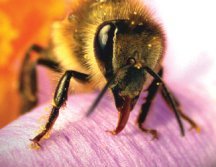Childhood chills give bees six left feet
If the bees are raised in cold temperatures, their dancing skills seem to go down the drain.
By Emily Sohn
Dancing well can help a person impress a first date. Honeybees have a lot more at stake. They do little dances to tell their nest-mates where they’ve found food.
If the bees are raised in cold temperatures, though, their dancing skills seem to go down the drain. What’s more, new research shows, chilled bees learn a lot more slowly than their warm-reared friends and relatives.
 |
|
A honeybee is best equipped to communicate by dancing if it developed in a warm nursery early in its life.
|
| F. Bock/Wurzburg Bee Group |
The work, led by Jurgen Tautz of the University of Wurzburg in Germany, may be the first to study how temperature affects dancing in adult honeybees.
Tautz and colleagues raised three groups of baby bees at three different temperatures: 32°C, 34°C, and 36°C. The same number of bees matured in each group, and all the adults looked the same.
The researchers tested learning in the bees by giving them whiffs of a citronella smell along with a treat of sugar water. Given another puff of citronella a minute later, bees from the warmest group were most likely to get ready for an upcoming treat by sticking out what looks like a long, thin tongue. Ten minutes later, the difference in memory among the groups was even greater.
When the bees were completely grown up, the cold-reared ones had the sloppiest dances. The researchers speculate that baby bees need to be kept warm during a critical period while their nervous systems are developing.
Who knows? Being warm when young may lead to hot times on the dance floor later in life.







